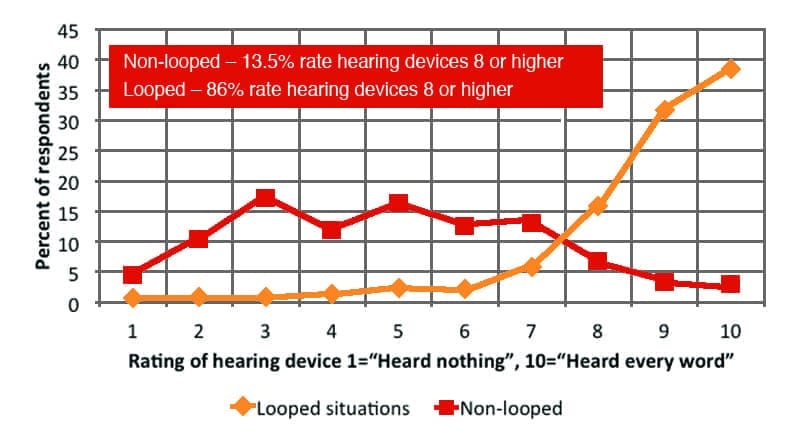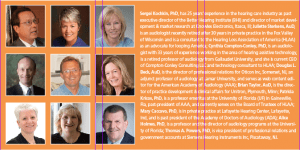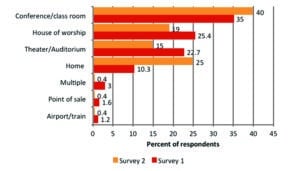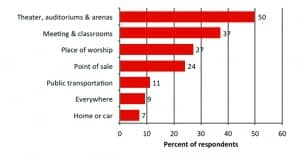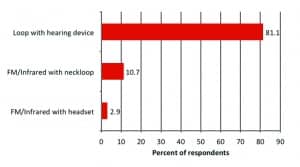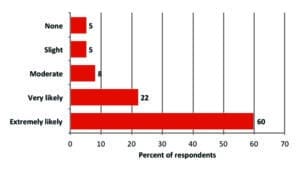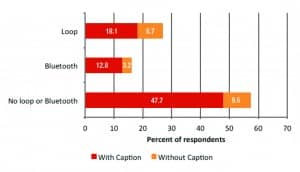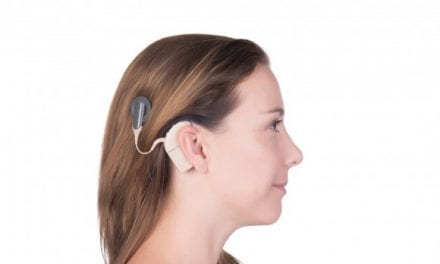Research | October 2014 Hearing Review
Using hearing devices with loop systems dramatically increases customer satisfaction
By Sergei Kochkin, PhD; Juliëtte Sterkens, AuD; Cynthia Compton-Conley, PhD; Douglas L. Beck, AuD; Brian Taylor, AuD; Patricia Kricos, PhD; Mary Caccavo, PhD; Alice Holmes, PhD, and Thomas A. Powers, PhD
It has previously been shown that hearing-aid adoption can be significantly improved by increasing the utility of hearing aids for people with hearing loss (Authors’ note: “utility” as used here indicates the number of listening situations in which the person is able to function effectively with the help of their hearing devices and/or assistive listening devices [ALDs]).
In the MarkeTrak series of publications, it was demonstrated that there is a very strong relationship between consumer satisfaction, brand loyalty, and the number of environments in which consumers derive utility from their hearing aids.1-2 Thus, hypothetically, as hearing aid utility increases, so too do hearing aid adoption rates. Indeed, patient loyalty is perhaps at a more critical tipping point than previously thought. Specifically, when one considers ratings below “satisfied” or “very satisfied,” one might conclude people who are less-than-satisfied demonstrate high levels of defection to competing hearing technology or alternative providers who offer better solutions.3
As documented in the latest MarkeTrak survey (2010),2 considering only ratings of “satisfied” and “very satisfied,” consumers report significant problems with the sound quality of modern hearing devices. The following problems were noted by these percentages of patients:
Furthermore, the MarkeTrak survey indicates that multiple environmental listening utility (MELU) of hearing aids can be improved. Despite significant advances in hearing aids over the last 10 years, consumers often complain about speech perception in noisy, spacious, and highly reverberant acoustic environments such as auditoriums, conference rooms, places of worship, point of sale counters, drive-throughs, public transportation, and theaters.4
Although the wireless revolution has improved near-field utility via remote microphones, FM systems, TV and cell phone connectivity systems, and more, some clients reject streamers and clip-on-microphones, as they report the technology may be too much of a hassle or unreliable in delivering a clean undistorted signal to the consumer’s hearing device(s). Admittedly, many tech-savvy consumers can make these wireless devices work and may even enjoy doing so! However, a simpler standardized, non-technical solution is needed for many consumers with less technical ability and for those who desire a simpler, efficient, and inexpensive solution. Although we don’t know with certainty, some industry experts predict a common wireless standard solution is many years away.
There is evidence a simpler non-technical solution is presented via hearing loop systems utilizing the telecoil in the consumer’s hearing devices. While all assistive listening systems bypass the acoustic space between the sound source and the listener, only hearing loops feed the audio signal wirelessly directly into the telecoil via electromagnetic waves. When the user activates the telecoil to receive the transmission from the loop system, they reduce the effects of distance, reverberation, and background noise, while maximizing the signal-to-noise ratio (SNR) between the person speaking and the person listening.
Despite the fact that inductive loops have been around for decades, little research has been conducted on the consumer’s experience. Diles5 compared consumers’ satisfaction watching TV with home loops versus without loops. He reported an 8-fold improvement in TV listening satisfaction with loops. Of note, the Diles study TV satisfaction ratings without loops are significantly lower than those reported in the national MarkeTrak study (last measured at 63% “satisfied” or higher).2 We surmise the lower TV satisfaction ratings in the Diles study were due to the concurrent ability of the consumer to compare TV in a looped and non-looped environment.
Nabelek, Donahue, and Letowski6 compared FM, IR, and loop systems to a PA system in a medium-sized classroom using the Modified Rhyme test (MRT). Participants in the study had normal hearing and hearing loss. For all groups, speech perception with each of the three listening systems was better than the PA system. The authors took great care that the loop system “assured high homogeneity of field strength,” allowing them to conclude that “the results of the speech perception testing indicate that a well-designed audio loop can be equally as effective as an FM or IR system,” and that “the decision about selection of one system [over another] should be based on considerations other than speech perception, such as cost, installation requirements, maintenance, interferences, and mobility.”
In a recent university study,7 various stimuli were presented to 26 hearing aid users and 47 non-users with normal hearing while listening with and without a hearing loop system in a reverberant auditorium. Test stimuli included the Hearing-in-Noise Test (HINT), music clips, and TV sitcom clips. People with hearing loss and people with normal hearing showed significant improvement with loops in speech understanding in noise, reduced effort in hearing comprehension, enhanced sound quality, as well as perceptions of increased pleasantness and naturalness of the sound source. Almost all (99%) of the subjects indicated a preference for listening with the hearing loop versus without. While the vast majority (96%) of people with hearing loss indicated they were “likely” or “very likely” to use a telecoil in looped venues, it was surprising that 48% of normal-hearing people also indicated they would use a telecoil in looped venues.
Objectives
The purpose of this study was to poll a large sample of people who wear hearing aids or cochlear implants (CIs), all of whom were exposed to looped venues, in order to characterize and understand their perceptions of the subjective benefit derived from the hearing loop systems. Subjects were asked to share their perceptions of the impact of the hearing loop system on:
- Their ability to hear better with their hearing devices;
- Their overall hearing device satisfaction;
- The likelihood of visiting venues featuring hearing loops;
- The overall quality of sound;
- Their perceived reduction in listening effort;
- Their ability to block out noise in difficult listening situations;
- Their ability to separate speech from music; and
- Their preference for looped versus other ALD systems.
Method
Two surveys were administered through the Internet (Survey Monkey).
Survey 1. The first loop survey8 was circulated among members of the Hearing Loss Association of America (HLAA), Sterkens’ @LoopWisconsin Blog on WordPress, the UK Website “Hearing Link,” and the blog “Hearing Health Matters,”9 as well as advertisements on Facebook and Twitter. The authors received 866 usable responses. The first survey consisted of 13 questions asking the respondent to focus their survey responses to a single looped venue. Subjects were asked to rate their hearing device within and outside of the looped venue, whether the loop increased satisfaction with their hearing devices, and their likelihood of seeking other looped venues in the future. Comments about their experience were also solicited.
Survey 2. Respondents who provided email addresses were sent a follow-up survey with more detailed questions. There were 243 usable responses to the second loop survey which consisted of 20 questions.10 Respondents were asked to think of a single looped venue and to provide more detailed, qualitative ratings of the impact of the loop on their ability to hear using their hearing device. In addition, respondents were asked to rank three ALD technologies used while watching TV, to provide information on the education they received regarding telecoils, and they were asked about membership in consumer-oriented hearing-help organizations. Finally, they were asked to provide commentary on the quality of sound while using their hearing devices in a loop.
![[Click on figures to enlarge.] Figure 1. What hearing device was used to experience inductive looping for Survey 1 (n=866) and the follow-up Survey 2 (n = 243).](https://hearingreview.com/wp-content/uploads/2014/09/KochkinFig1-300x157.jpg)
[Click on figures to enlarge.] Figure 1. What hearing device was used to experience inductive looping for Survey 1 (n=866) and the follow-up Survey 2 (n = 243).

Figure 2. Subjective hearing loss comparing loop survey samples and US hearing aid owner population (MarkeTrak VIII).
Figure 2 shows survey respondents’ subjective self-ratings for the severity of their hearing loss, compared with MarkeTrak VIII (2010) US statistics.2 In general, this suggests a much larger percentage of survey respondents had profound hearing loss than the general population, almost certainly a result of the high HLAA membership response to the surveys.
Thus, it is important to understand that this is not a representative sample of hearing device users. Rather, it is considered a convenience sample; that is, we cannot tell if the respondents represent a biased sample (ie, a sample of people who are more “pro-loop”). It is entirely conceivable that anti-loop or pro-wireless respondents did not respond. To our knowledge, no attempt was made to alert respondents that surveys were being conducted to gain national support for looping. Nevertheless, it should be kept in mind that the vast majority of respondents were members of HLAA who were likely aware that HLAA strongly supports the “Let’s Loop America” campaign,12,13 and the title on each Survey Monkey was “Get in the Hearing Loop.” Likewise, we were unable to verify the appropriateness of the respondents’ telecoil setting, we do not know if they were able to select and properly use their telecoil, nor do we know anything about the quality of the hearing loop installation they experienced.
With these caveats in mind, we reveal the experiences of a large sample of consumers with hearing losses who used their hearing devices in hearing loop systems.
Results
Hearing loop users were asked to focus on one looped venue when responding to both surveys. Their chosen venues for both surveys are shown in Figure 3. The most frequent venues mentioned were conferences/classrooms, houses of worship, theater/auditorium, and home. Only a few respondents mentioned stores and ticket windows (point-of-sale) or public transportation, conceivably because few of these places in the United States are looped.
In Survey 1, subjects were asked to rate their hearing device on a 10-point scale ranging from “1 = heard nothing” to “10 = heard every word” in looped and non-looped situations. The frequency distributions of these ratings are shown in Figure 4. Only 13.5% of respondents in the non-looped situation rated their hearing device an 8 or higher (mean=4.9; median=5; mode=3), compared to 86% in a hearing loop system (mean=8.7; median=9; mode=10). As demonstrated in Figure 5, nearly 9 out of 10 respondents “strongly agreed” or “agreed” the hearing loop system increased their satisfaction with their hearing aid or cochlear implant.
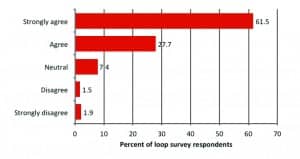
Figure 5. Consumer evaluation of increased satisfaction with hearing devices due to use in looped situations.
Respondents were asked to indicate which listening environments they were most interested in having looped (Figure 6). Large spaces such as theaters, auditoriums, and arenas were #1 (50% of mentions), followed by meetings and classrooms (37%), places of worship (27%), and point-of-sale locations (24%). A small minority reported interest in public transportation (11%) and private places like home or car (7%).
Consumers were asked to comment on their hearing loop system experience in the first survey. Of the 866 respondents, 418 (48%) left comments regarding the loop function or their ability to benefit from the loop. Of those, 84% of comments were positive and nearly half of those were highly enthusiastic.
Some examples of positive comments: “I didn’t have to work so hard to hear the speaker”; “In a loop I don’t need to read the captions”; “No more need to read lips”; “Freeing”; “Feels like I have normal hearing”; “The clarity in a loop is amazing”; “I could hear things my wife could not hear”; “So much better I cried”; “I would not attend (meetings, church services etc) if they did not have a loop”; “It is awesome to be able to understand, not just hear. I don’t think folks with normal hearing can appreciate just how awesome it is!”
A total of 84 (10%) respondents left negative comments (addressed later in this article) about the loop functioning, yet only 44 people (5%) reported the loop was of no benefit to them at all. Nine people (3%) indicated that, due to the severity of their hearing loss, they were unable to understand speech without the use of lip-reading and/or captions and 11 respondents (1%) revealed they were able to hear without using a loop.
In Survey 2, respondents (n=243) were asked to describe in more detail their experiences in looped venues. Once again, they were asked to focus on one venue as documented in Figure 3. They were asked to rate their experience with a loop compared to their hearing devices without a loop by using a 11-point qualitative scale (-5 to +5 with zero noted as “no change”) for five attributes:
- Sound quality: -5 “poor quality” to +5 “great quality”
- Ability to understand speech: -5 “much worse understanding” to +5 “much better understanding”
- Need to concentrate: -5 “More need to concentrate” to +5 “less need to concentrate”
- Easily ignore background noise: -5 “very hard to ignore background noises” to +5 “very easy to ignore background noises”
- Separate voices from music: -5 “very hard to separate the voices from music” to +5 “very easy to separate the voices from music”

Figure 7. Overall rating of quality of looped venues in Survey 2 (n=243). Mean of sound quality, speech intelligibility, ease of concentration, mitigation of background noise, and ability to separate speech from music (scores take the value -5 to +5).
Nearly 7 out of 10 subjects indicated hearing loop systems significantly improved (scores of +4 or +5) sound quality, speech intelligibility, concentration, and reduced background noise while using their hearing device. Approximately 4 out of 10 (38%) indicated the room loop helped them separate voices from music. Considering the overall average ratings in Figure 7, 2 out of 3 respondents rated their loop experience a +4 or higher. (A factor analysis of these five ratings demonstrated there was one underlying factor [Eigenvalue=3.4, variance explained=68%]. The average rating frequency distribution is presented in Figure 7 and the detail for the five ratings is in Table 1.)
Of note, only a small minority (7-9%) reported no change or degradation in their listening experience in looped venues with respect to sound quality, speech intelligibility, concentration, and background noise. A more sizable minority (24%) reported no change or worse performance in their ability to separate voice and music.
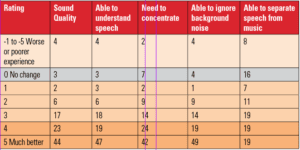
Table 1. Consumer ratings (% of respondents) of their hearing devices in looped versus non-looped situations (Survey 2, n=243).
The negative comments regarding hearing loops referred primarily to complaints about sound quality and issues about their particular telecoil and loop situation:
1) Quality of the hearing loop installation.
a) The hearing loop did not provide an even signal in the venue: “The signal in the loop was too loud/not loud enough in some areas of the loop”; “The hearing loop is not loud enough in the center of our sanctuary.”
b) The hearing loop was installed in an area where electromagnetic noise was present: “There is too much interference or static in the loop”; “I couldn’t understand the agent because of buzzing”; and one person indicated that “Even with buzzing, the understanding (in a loop) is much better.”
c) Several complaints centered on sound problems such as improper use of microphones, sound mixing, or operator error: “The presenters did not speak into the microphone”; “The loop was not turned on”; “The hearing loop only amplified the background noise”; “[The loop] picks up music as well which drowns out speech.”
2) Issues related to the telecoil.
a) Orientation: “I hear a chainsaw like background noise when I use the telecoil in my cochlear implant”; “Poor alignment of the telecoils in my hearing aids makes them sensitive to direction”; “I have to hold my head a certain way in order to hear.”
b) User’s inability to hear ambient sound on the “telecoil only” setting: “I don’t like not hearing my own voice”; “I was unable to hear the persons sitting next to me”; “I felt vulnerable and alone.”
c) The user’s ability to handle the telecoil adjustment: “I am not sure if I turned on the telecoil”; “I don’t use (the telecoil) often, so it is hard to figure out how”; “When I leave church, I sometimes forget to turn off the loop and can’t hear properly.”
3) Role of the hearing healthcare professional. The comment of one respondent referred to the importance of the role of the hearing care professional in the programming of the telecoils: “…This experience has worried me and made me wonder if there are people trying the loop and not finding it as amazing as I did—but don’t know it’s a hearing aid problem and not the loop itself.”
When presented with three ALD systems (Figure 8)—Loop with hearing device, FM/infrared with neck loop, or FM/infrared with headset—about 4 out of 5 (81%) chose a hearing loop system as their most preferred ALD. It should be noted that the data in Figure 8 only considers preferred ALD technology the subject had previously experienced; 37% never used FM or infrared with a headset, while 33% never used FM or infrared with a neckloop. Only 125 respondents had previously experienced all three technologies. Concentrating on this sub-sample, the ALD preferences do not change dramatically: 88% loop with hearing device, 12.8% FM/infrared with neckloop followed by 4.8% FM/infrared with headset. The respondents in this survey were so impressed with hearing loop systems that 82% indicated they were “very likely” or “extremely likely” to seek out ticketed venues utilizing hearing loop systems (Figure 9).
Television listening. Television is one of the most important listening situations for consumers, yet only 63% of typical hearing aid users report they are “satisfied” or “very satisfied” with their experience.2 A common complaint when viewing television is degradation of the sound source and great difficulty separating speech from music.
We asked this sample of hearing device users to tell us which technology they used. As shown in Figure 10, the majority (57%) used neither a loop nor Bluetooth with their hearing device while watching TV, while slightly more than 1 in 4 used home loop, and only 1 in 7 used Bluetooth (we acknowledge the consumer could have used other wireless technologies other than Bluetooth). This is disappointing, since this near-field listening experience is a solvable solution with the use of home loops, inexpensive cushion loops, or other wireless connections to the TV (Bluetooth, 2.4 GHz, FM, IR, etc).
Diles5 reported a 90% overall hearing aid satisfaction when home looping is used for TV/stereo listening with his customers (n=71). Clearly, an enhanced TV listening experience will have a positive impact on overall hearing device satisfaction.
Education about existence of t-coil in a patient’s hearing aid. To make the world more accessible to people with hearing loss, when possible, hearing aids must have telecoils, or there needs to be a simple, universal wireless standard to connect to the outside world. When talking with industry experts, the consensus is the majority of hearing aids already have telecoils in them. Yet when consumers are asked if their hearing devices have telecoils (MarkeTrak VIII, October 2010), only 34% indicate they are aware there is a telecoil in their hearing aid.2
Figure 11 suggests a serious educational issue in that only 35% of respondents indicated the hearing care professional demonstrated the use of a telecoil when fitting the hearing device. While the focus of this study was on hearing loop experiences among hearing device users, it is important to note that for hearing device users to benefit from ADA-mandated hearing-aid compatible FM and infrared listening devices offered in public venues around the country, a telecoil is needed.

Figure 11. Did the hearing healthcare professional demonstrate the telecoil to the consumer when fitting the hearing device?
A consumer survey by Ross and Stika14 validates the educational gap found in this survey and in MarkeTrak. Specifically, fewer than 50% of respondents noted they received information on telecoils from their hearing care professional. This educational gap makes it unlikely the consumer can understand and benefit from the telecoil in their hearing aid.
Discussion
Our findings clearly demonstrate hearing loop systems dramatically improved consumer experiences with their hearing devices (hearing aids or CIs) for nearly all participants. The polled group of users reported looped venues significantly improved their speech intelligibility and the sound quality of their hearing device, as evidenced by the change in their average subjective rating of 5 with just their hearing devices (on a 10-point scale of “1 = heard nothing” to “10 = heard every word”) to nearly a 9 in a hearing loop system.
As a result of their enhanced listening experience, consumer satisfaction for hearing devices increased and we recorded numerous enthusiastic comments. Our findings suggest telecoils and loops do not benefit consumers whose speech understanding is so reduced that they require captions.
Installation, programming, EMI, and orientation issues. It is important for the reader to understand that most of the above-mentioned consumer concerns, which are specifically addressed in the IEC Hearing Loop Standard 60118-4,15 may not have been an issue if the loop had been properly installed by a trained installer. In addition, for this report, we have no way of knowing if the hearing loops were professionally installed, if they met the standard, if the telecoils were properly positioned (eg, had a vertical orientation when worn), were properly programmed, or the telecoil programs were appropriately accessed.
The issue of electromagnetic interference (EMI) is often discussed as a drawback to the use of room loops. However, it is important to understand that EMI is not an issue with room loops only. Because it affects telecoil performance, it can be problematic when FM and infrared systems are used with inductive coupling devices such as neckloops and silhouette inductors. Under mandate by the Americans with Disabilities Act (ADA), large-area venues must provide a certain number of neckloops for coupling purposes. Neckloops are recommended as they are a generic and thus a reasonable accommodation. So, even with FM and infrared systems, EMI can be an issue—not only for the telecoil located inside a hearing aid or implant, but also the telecoil located inside a streamer. Thus, before any of the three major large-area systems are installed, care must be taken to eliminate EMI when possible.
While it is true that electromagnetic interference (EMI) has sometimes created challenges for telecoil coupling in the past, it is expected to be less of a problem in the future due to a reduction in emissions of electrical and electronic devices. For example, fluorescent lighting and CRT monitors that gave off significant amounts of EMI are rapidly being replaced by modern lighting and monitors with little or no EMI concerns.
Orientation problems with telecoils can be eliminated by using a vertical mount inside the hearing instruments along with proper alignment on the head (eg, ensuring hearing aid tubing is not cut too long or short). Orientation concerns become less of a problem with the use of phased array hearing loop installations. These systems can transmit the magnetic signal in two directions, eliminating the directivity and orientation complaints of hearing loop users. We believe that, if all evaluated hearing loop systems met the IEC standard, the results of these surveys would have been even more dramatic.
Advantages of loop systems. While all large-area assistive listening systems provide an improved SNR for the end-user, hearing loop systems have several distinct advantages:
- They are universal and directly compatible with any brand of hearing aid or implant that has a telecoil.
- They are dignified in that they do not require the hearing instrument user to call attention to him or herself.
- They are convenient in that they do not require the user to take the time to borrow and return portable receiving units and coupling devices.
- They are easy to use in transient communication situations such as service desks and kiosks.
- They are elegant in design and do not require an undue amount of training for either users or installers.
It is our opinion that telecoils and hearing loops deserve the attention of the hearing industry and hearing care professionals, as these simple devices dramatically increase multiple environmental listening utility (MELU).1
Successful hearing loop initiatives in Michigan, California, Indiana, Florida, and Wisconsin have demonstrated hearing loop systems become the assistive listening technology of choice when hearing care professionals become involved. Of note, telecoils need to be properly programmed to match the microphone response, and consumers need to be counseled regarding the difference between the telecoil-only (T) versus microphone + telecoil (M + T) programs.
Loops should be installed in treatment and waiting rooms so consumers have the opportunity to fully experience the loop’s benefits and can practice turning the telecoil on and off. If consumers are supplied with information on where to find looped venues locally and are encouraged to “try them out,” they will not only become active telecoil users but they will recommend the technology to others. This leads to people actively searching out hearing looped venues and self-advocacy for additional installations.
Taylor16 recommends as part of branding one’s practice and marketing strategy that hearing care professionals take an active role in community outreach centered on the installation and use of loop systems. This could include recommending loops where none are installed, encouraging clients to more actively advocate for themselves, as well as financially contributing to hearing loop installations through directed donations.
It is admirable that hearing aid manufacturers have agreed to pursue a universal wireless standard intended to replace existing wireless technologies. However, as this standard may be many years away, we urge HIA and EHIMA to continue to support and improve telecoils for the benefit of current hearing device users. By offering telecoil programming and verification in CEU classes, hearing care professionals can quickly be brought up to speed on modern telecoil programming. The industry can support the hearing loop movement (see sidebar) by offering printed “Telecoils Help You Hear in Public Hearing Loops” pamphlets, which include self-advocacy cards with each hearing aid sent out to empower consumers. Loop listening devices built into smart phones, currently available only as prototypes, will further help advance hearing loop technology.
Until we have a universal way of connecting people to a variety of near- and far-field sound sources, the needs assessment and selection process for hearing enhancement technology must embrace both old and new technologies. For example, at home or at work, the case could be made for streamer systems that allow the listener to walk into a room and automatically begin hearing the TV or a conversation. However, consumers must also be made aware that streamer technology will not provide access in public venues outfitted with loop, FM, and infrared systems unless 1) The streamer contains a telecoil, or 2) The hearing instruments themselves are telecoil-equipped.
Finally, for various reasons, not everyone is a candidate for streaming technology. Need should determine the technology choice, not the other way around.
- For the foreseeable future, potential enhanced telecoil functioning may be critical for reconnecting people with hearing loss to the world of sound. These enhancements may include:
- Voice prompts (currently available via one manufacturer) would benefit the many consumers who currently struggle to remember what one, two, or three beeps mean;
- User adjustable M+T function mixing via remote control or smart phone to allow users the ability to control microphone input where more/less near-field signals are desired (ie, this feature is currently available via one CI manufacturer);
- Digital noise reduction applied more aggressively to the telecoil function to reduce electromagnetic background noise from network wires and lighting systems;
- Sensor functions on every telecoil instrument that alert consumers through a voice prompt (eg, “Hearing loop signal present; push button to activate”) whenever users walk into a field where electromagnetic speech signals are present would further enhance the current hearing loop users’ experience.
By educating consumers and venues about the benefits of hearing aid compatible loop systems, the concomitant improved hearing aid functionality, and the good word-of-mouth that accompanies the improved MELU in places where hearing devices alone are unable to deliver, consumer demand for hearing services will increase.
While the data presented in these two short surveys are encouraging, we must conclude this study by acknowledging its limitations. This sample, despite being sizeable, was a convenience sample from people who currently use looped technology and, in many cases, belong to an organization (HLAA) dedicated to looping America. This is not a random sample of hearing device users. Many of the conclusions may be very true for the more severely impaired hearing loss population. But, if the sample had milder hearing losses or if subjects were exposed to other wireless technologies, the results could have been different.
However, we are encouraged by the findings from controlled studies demonstrating that “typical” hearing aid users and normal-hearing people experienced significant benefit while in a looped reverberant auditorium7 and in a classroom.6 The authors hope that the research presented here will encourage more clinical, as well as real-world investigations, into the benefits of looping.
Getting Your Patients Looped
Resources on Hearing Loop Systems
For those who want to learn more about looping and becoming Hearing Loop System advocates, here are the top resources to get you started.
- Hearing loop advocate David Myers’ informational website: www.hearingloop.org
- Hearing Loss Association of America (HLAA) “Get in the Loop Campaign” and associated materials: http://www.hearingloss.org/content/get-hearing-loop
- A “How to Guide” for Practitioners at www.loopwisconsin.com/PDFFiles/ADA-invigoratepracticeLR.pdf and “Telecoil Essentials” at www.loopwisconsin.com/PDFFiles/ADA-getinloopJS.pdf
- “Roadmap to a Looped Community” article (with permission from American Academy of Audiology): www.loopwisconsin.com/PDFFiles/SterkensATMayJun.pdf
- “Hearing Loops: The WOW Factor—Hearing Beyond 8 Feet”, an AudiologyOnline webinar at: www.audiologyonline.com/audiology-ceus/course/hearing-loops-wow-factor-beyond-24045
- Tools and useful resources created by Academy of Audiology and Hearing Loss Association of America Get in the Loop Joint Task Force at: www.audiology.org/publications-resources/consumer-information/get-hearing-loop
- Co-author Juliette Sterkens can be contacted at [email protected] for access to a Dropbox file with adult and pediatric patient handouts, PPT presentations, looping articles, and sound files.
Acknowledgments
This publication was made possible by grants from: Etymotic Research Inc, a leading research (including ongoing telecoil research), development, and manufacturing company that has designed innovative products for over 30 years; Contacta Global, a US manufacturer of hearing loop systems that offers IEC Standard installation training and technical support based on real experience and a thorough understanding of all that’s required to deliver a working loop system; Listen Technologies, which offers leading assistive listening solutions that are compliant with government regulations and also bring clear, focused, and personalized audio to all kinds of performance venues and public spaces; IntriCon Corporation, which designs, develops, and manufactures micro-miniature body-worn medical and electronic products based on proprietary technology and is a leading world supplier of digital circuit solutions and algorithms for the hearing care industry; and Univox by Edin, a Sweden-based company that designed the very first constant current loop driver in 1969 and are constantly developing their products to improve the life of millions with hearing loss all over the world.
References
1. Kochkin S. Increasing hearing aid adoption through multiple environmental listening utility. Hear Jour. 2007;60(11):28-49.
2. Kochkin S. MarkeTrak VIII: Customer satisfaction with hearing aids is slowly increasing. Hear Jour. 2010;63(1):11-19.
3. Kochkin S, Dennison L, Jackson L. What is your customer loyalty quotient (CLQ)? Hearing Review. 2014;21(9)[Sept]:46-51.
4. Sterkens J. Roadmap to a looped community. Audiology Today. May/June 2014:26-31.
5. Diles W. Get your patients “in the loop.” Hear Jour. 2006;59(5):22-23.
6. Nabelek AK, Donahue AM, Letowski TR. Comparison of amplification systems in a classroom. J Rehab Res Develop. 1986;23(1):41-52.
7. Magann Faivre R, Ismail F, Sterkens J, Thunder T, Chung K. The effects of hearing loop systems on speech understanding and sound quality in real world listening environments. Poster session presented at: Northern Illinois University Audiology Clinic, NIU Speech and Hearing Clinic; May 9, 2013.
8. Loop Survey #1. Available at: https://www.surveymonkey.com/s/hearing_loop
9. Kirkwood D. As hearing industry seeks new wireless standard, t-coil advocates say not so fast. May 19, 2014. Available at: http://hearinghealthmatters.org/hearingnewswatch/2014/hearing-industry-seeks-new-wireless-standard-hearing-aids-t-coil-advocates-say-fast/
10. Loop Survey #2. Available at: https://www.surveymonkey.com/s/hearing_loop_2
11. Kochkin S. MarkeTrak VIII: 25 year trends in the hearing health market. Hearing Review. 2009;16(11)[Oct]:12-31.
12. Myers D. Progress toward the looping of America—and doubled hearing aid functionality. Hearing Review. 2010;17(2)[Feb]:10-17.
13. Shaw G. A surge in hearing loops gives hearing-impaired front row seats. Hear Jour. 2012;65(9):14-17.
14. Ross M, Stika CJ. Hearing aid services and satisfaction: The consumer viewpoint. Available at: http://www.hearingresearch.org/ross/hearing_aid_use/hearing_aid_services_and_satisfaction_the_consumer_viewpoint.php
15. Univox by Edin. Standard for the measurement of induction loops-IEC 60118-4:2006. Available at: http://www.univox.eu/iec-60118-4
16. Taylor B. Modernizing your marketing efforts for today’s marketplace [webinar]. Available at: https://www.ihsinfo.org/ihsv2/Ceus/pdf/july2012/Modernizing%20Your%20Marketing_July%20Soundboard.pdf
17. Beck DL. Personalization and concepts in advanced Audiology. Paper presented at: Florida Academy of Audiology, Sanibel, Fla. August 2014.
CORRESPONDENCE can be addressed to Dr Kochkin at: [email protected]

